Dear Reader, in this age of AI created content, please support with your goodwill someone who works harder to provide the human-made. Sign up at the top of the lefthand column or bottom of this page. You will receive my hand illustrated monthly newsletter RESTORE NATURE and access to the biodiversity garden design course as I write...and nothing else, I respect your time. I am also removing the advertizing as best I can as its become intrusive inappropriate and pays me nothing.
Grow passion fruit or granadilla from seed
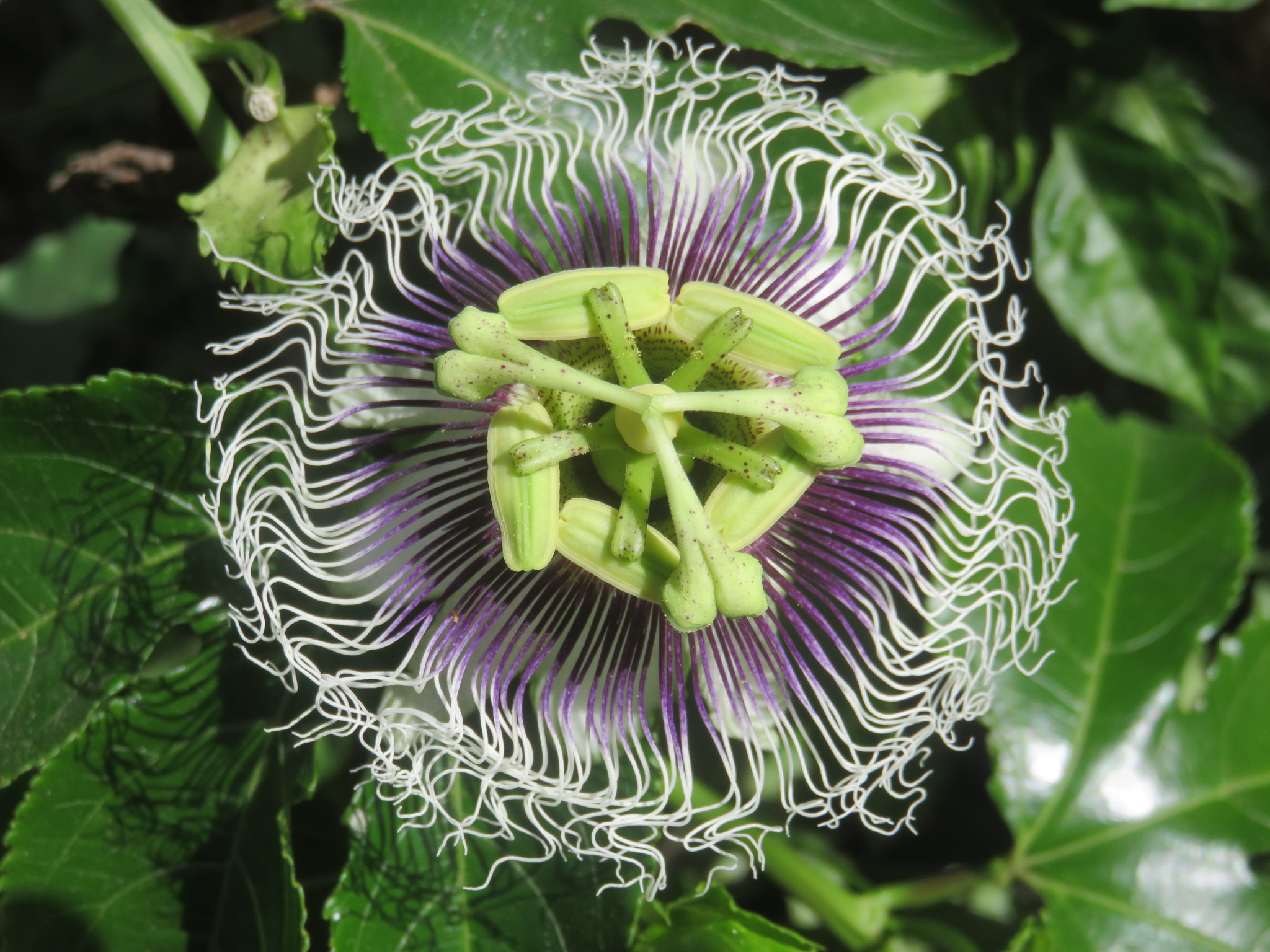 Grow passion fruit and be treated to this gorgeous flower.
Grow passion fruit and be treated to this gorgeous flower.In late 2017 I came to grow passion fruit from seed because of the prolific vine in a friend's garden. His vine bears heavily and he was able to give us a small basket full of fruit. By the time I got to paying them attention the fruit were no longer edible, so they were used for propagation instead.
The granadilla or passion fruit is easy to grow from seed, and the fruit makes a delicious ingredient in fruit salads and cold summer drinks, jellies and many other summery recipes.
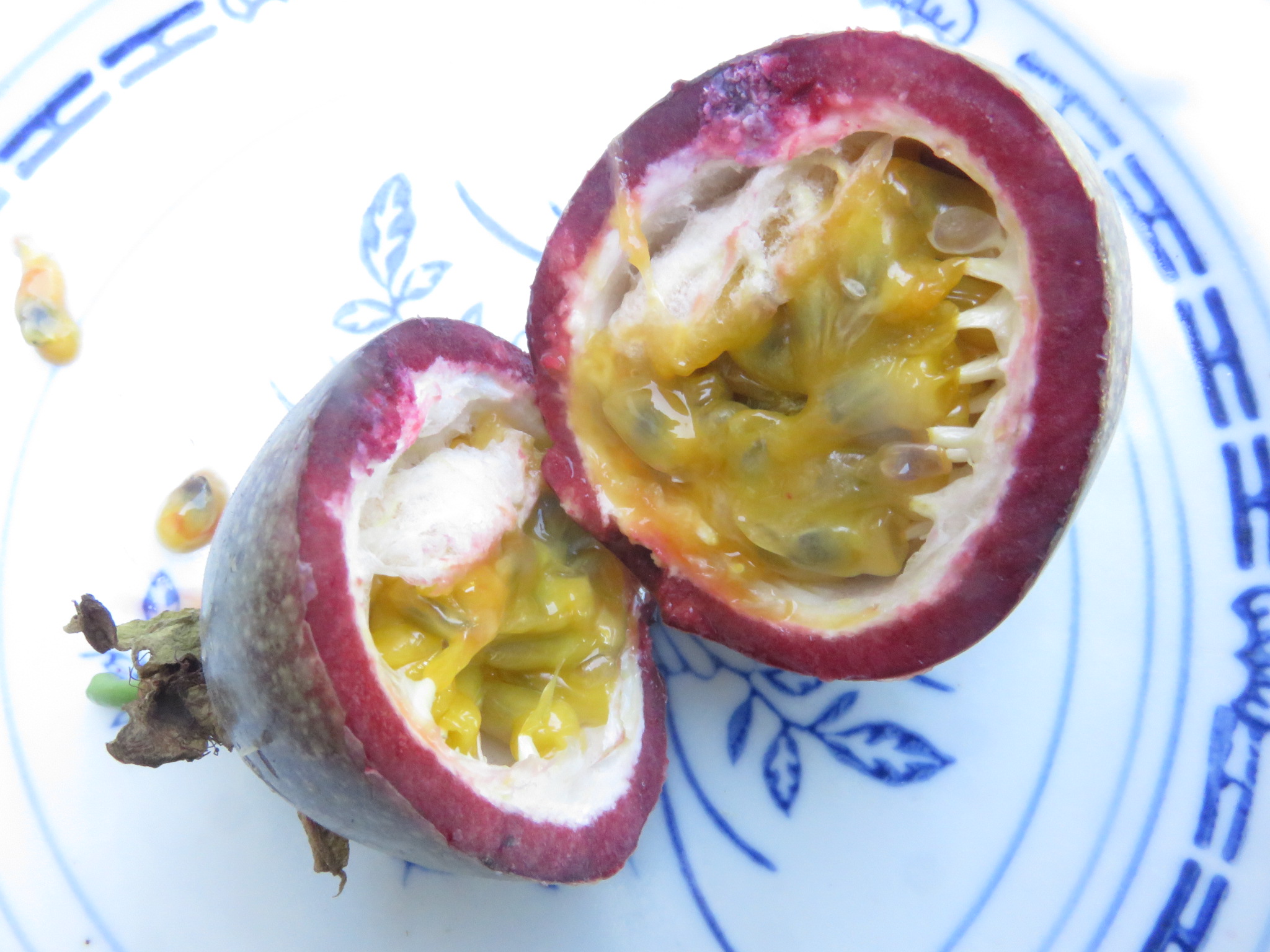 Passion fruit grow well from fresh seed like this.
Passion fruit grow well from fresh seed like this.How to grow passion fruit
from seed
I scooped out the
fruit pulp full of seeds and fermented it for 10 days to separate the
pulp and seeds. Then I washed them and
planted them 8mm (half an inch) deep in 10cm (4 inch) deep polystyrene
trays made of old fish packaging boxes.The seeds were wet when I planted
them, so it may help hydrating them in water before planting if your
seeds are dry.
The weather was warm, from our spring to midsummer, in which average day time temperatures climb from 21 in September to 27 degrees C in December (70 - 81 F). You could try germinating them indoors if the weather is colder. Within two months the granadilla vines had come up. I had a lot of unlabeled seedling trays and I only identified them when they were quite large, as the young leaves are entire and not divided into three parts, and they don't have tendrils or a tall vine like growth at first. The young leaves are glossy, roughly elliptic in shape with smooth margins.
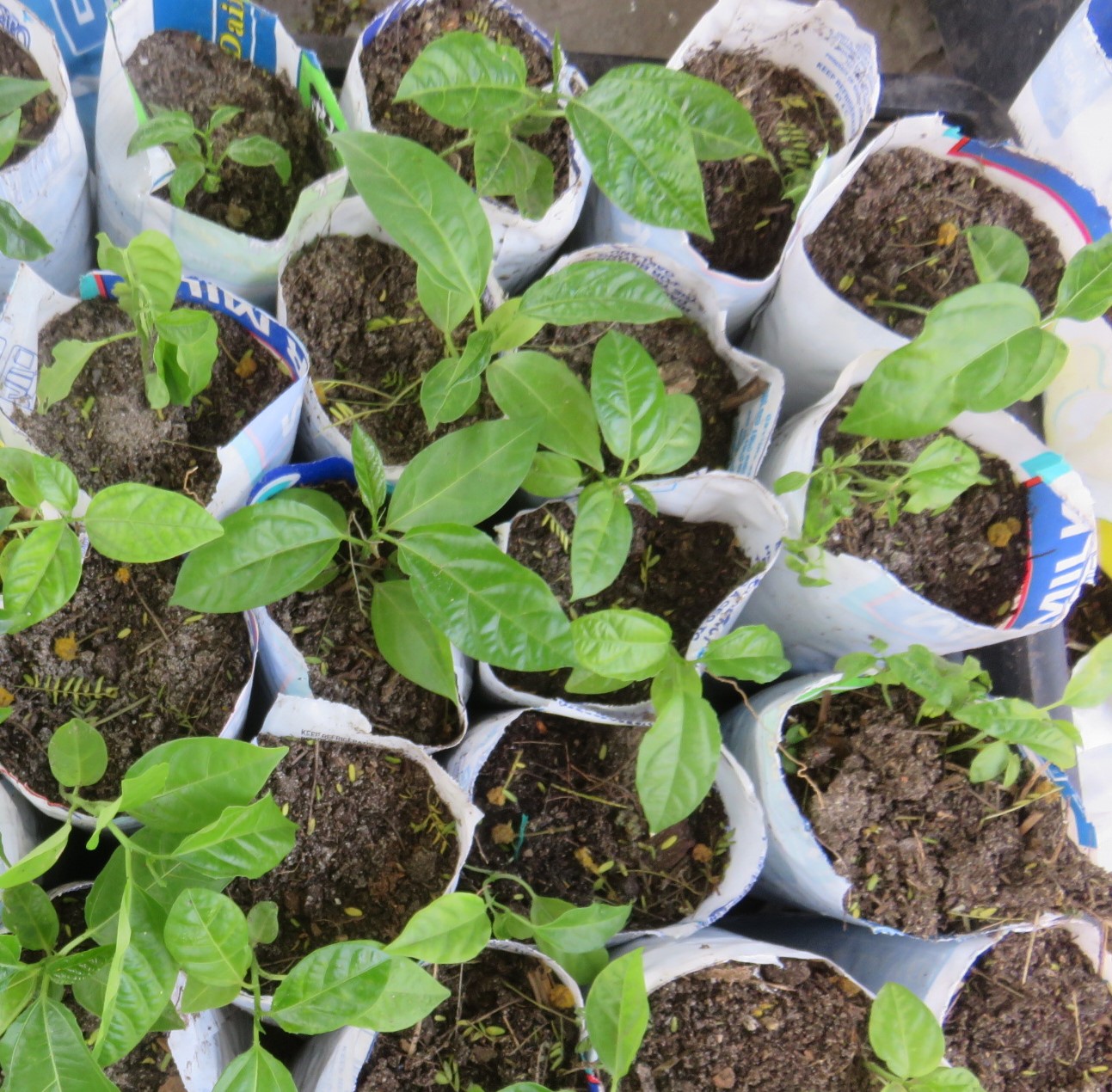 Young passion fruit vines lack an elongated form, divided leaves and tendrils
Young passion fruit vines lack an elongated form, divided leaves and tendrilsThe granadilla vines that I raised grew rapidly to about a height of 50cm (20 inches) and then remained quite static as they became root bound in their containers.
After planting out in the garden they needed really strong snail protection to make it. When the first commercial vine was gnawed back to only half a leaf, I covered it in a protective tube made of mosquito net with the bottom edge buried in the ground and the top edge sewed closed. After recovering from this insult the vine got going and eighteen months later is covering an area of about 16 square meters (19 square yards).
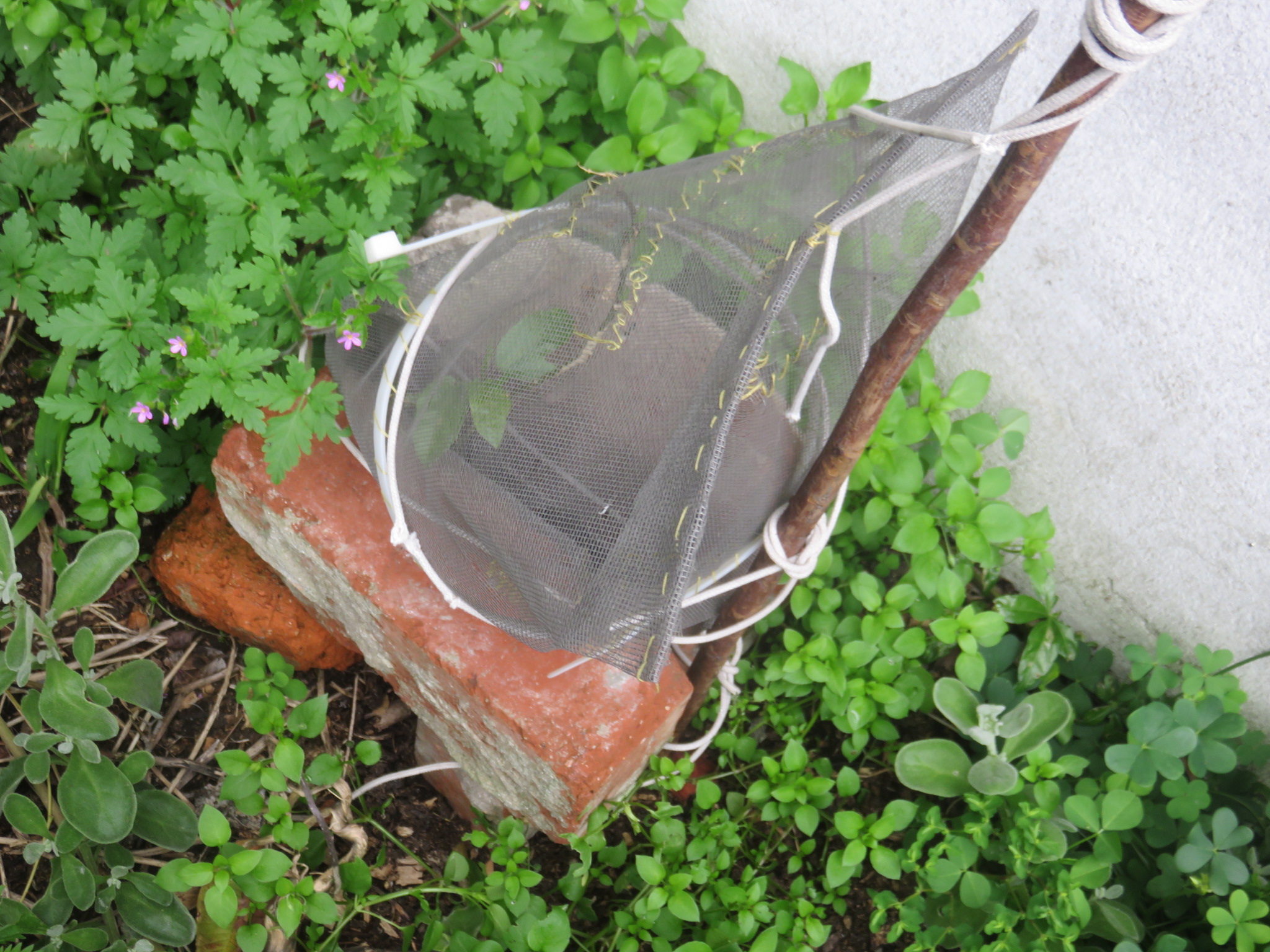 This tube sewn out of plastic mosquito of fly screen excluded snails
This tube sewn out of plastic mosquito of fly screen excluded snailsBesides a large commercially bought granadilla vine, I have two other vines grown from seed of about four meters squared (5 square yards) coverage each which I hope increase the chances of having a good bearer, and three others coming up, which are still quite small. I think I have left the ones grown from seed too long in their pots, and they may never really get large. This year I will raise a second generation from seed and hopefully keep better tabs on plant growth, germination times and repotting.
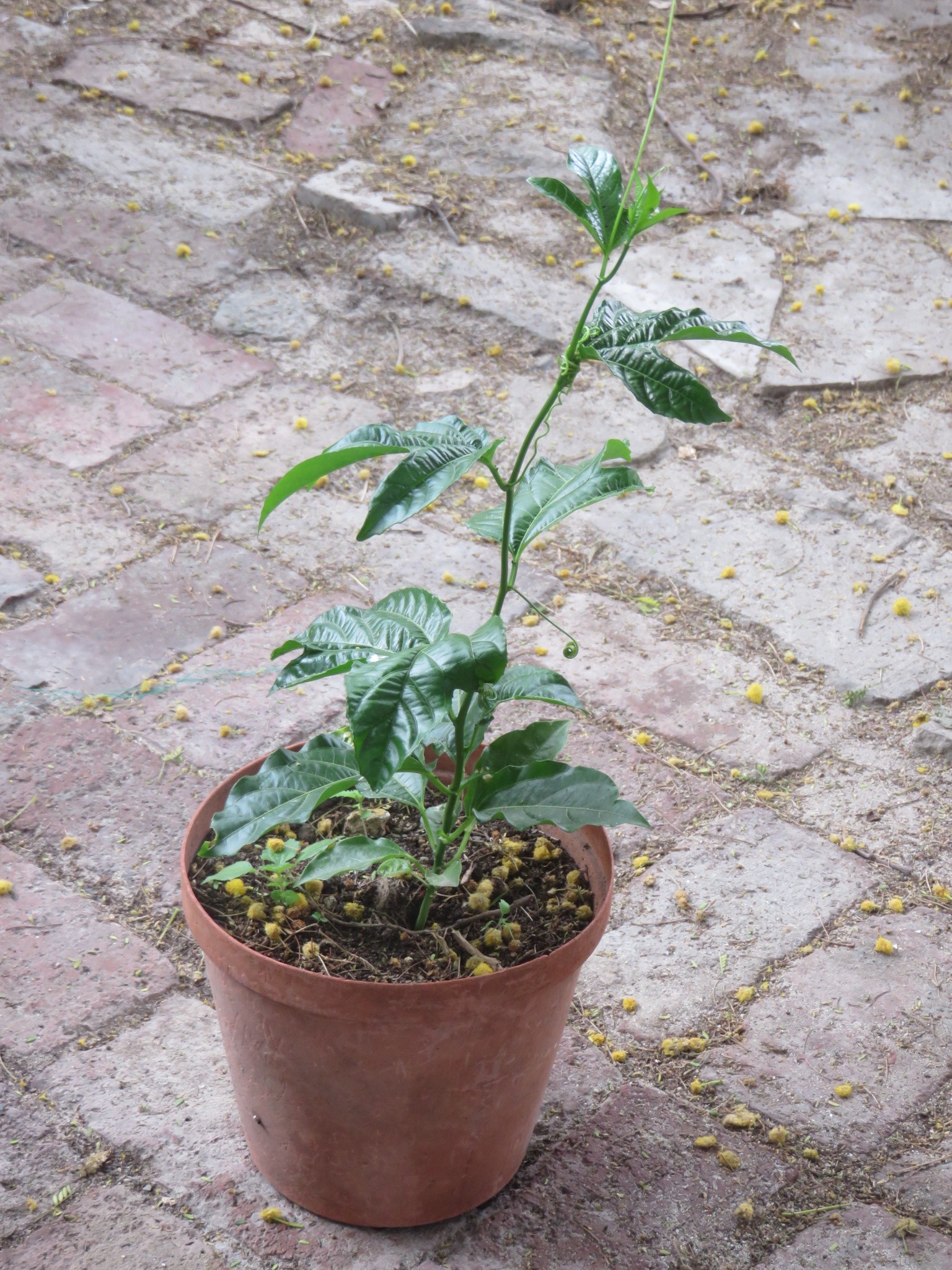 A vine ready to plant out A vine ready to plant out |
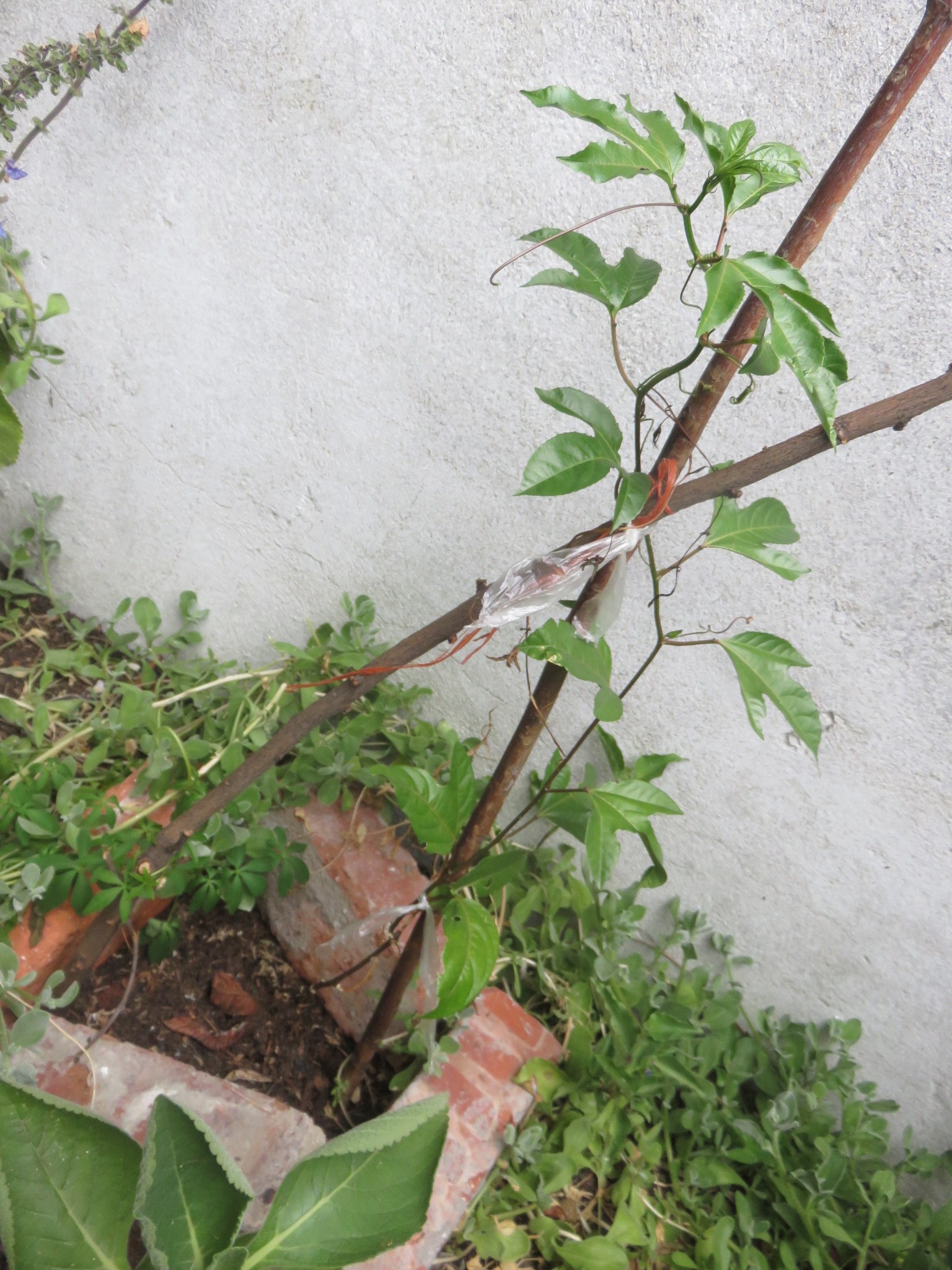 recovered from snail attack recovered from snail attack |
Reasons to grow passion fruit from seed
Everyone knows how delicious passion fruit is. We've already
mentioned how easy it is to grow, and hardy plants are needed in a
drought resistant garden.
Contrary to popular lore, in my experience when you grow passion fruit from seed they bear better than commercially bought vines. Perhaps it is just luck.
The vines grown from fruit from my friend's garden vine are bearing, whereas the commercial shop-bought vine I acquired, at about this time, is massive, flowers profusely but never produces fruit. Perhaps it is the self-sterile yellow type of fruit. My friend's vine was a purple fruited vine, which is self pollinating.
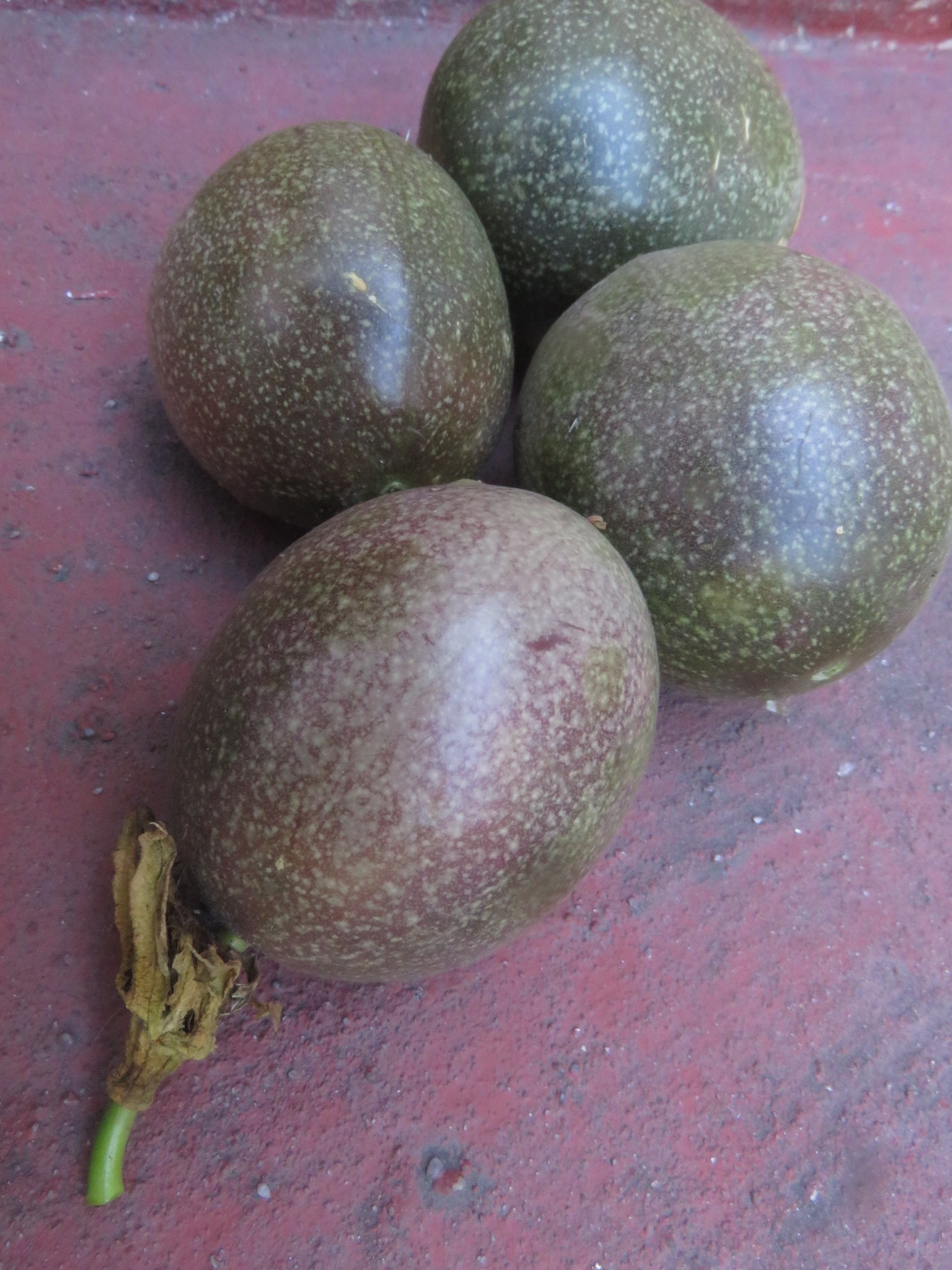 The purple fruited vine is self pollinating
The purple fruited vine is self pollinatingThen again, it may be nurture rather than nature. The big vine, of commercial stock, that has not fruited, is growing in an ancient worm bed, and was watered daily. The vine that is bearing well grows in nutrient poor sand that has never been used as a worm bed, but is close to the standpipes of the fish pond and gets some nutrient rich water when the pond is flushed once a fortnight. The appearance of their average leaf size and form and the more subtle difference in flower form can be seen below. The large vine is on the left, and the fruitful one on the right. The commercial vine on the left does have the pattern of vigorous vegetative growth due to oversupply of nitrogen. This tends to impact negatively on fruit formation.
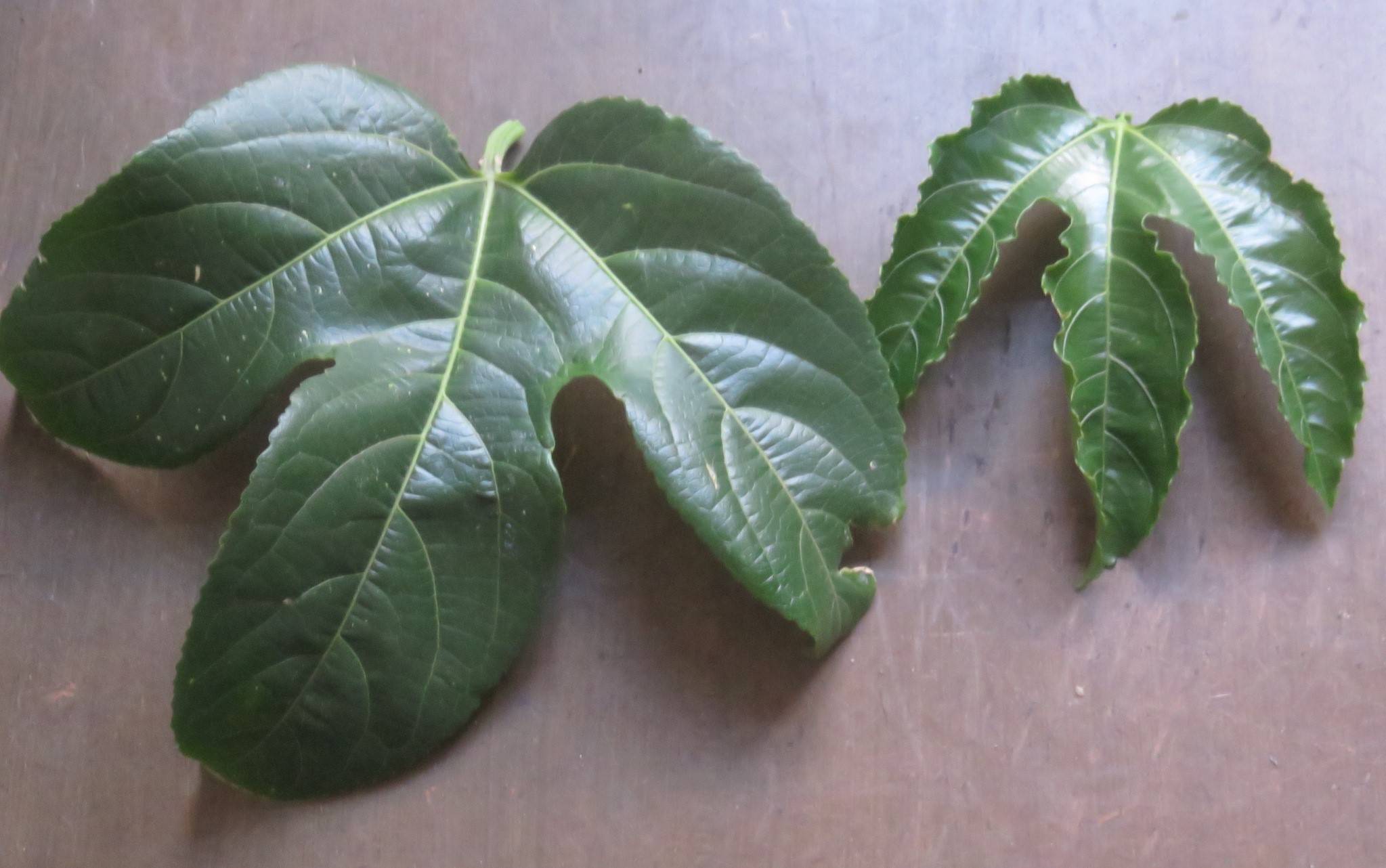 Left: bought vine, no fruit. Right: grown from seed, bears copiously.
Left: bought vine, no fruit. Right: grown from seed, bears copiously.
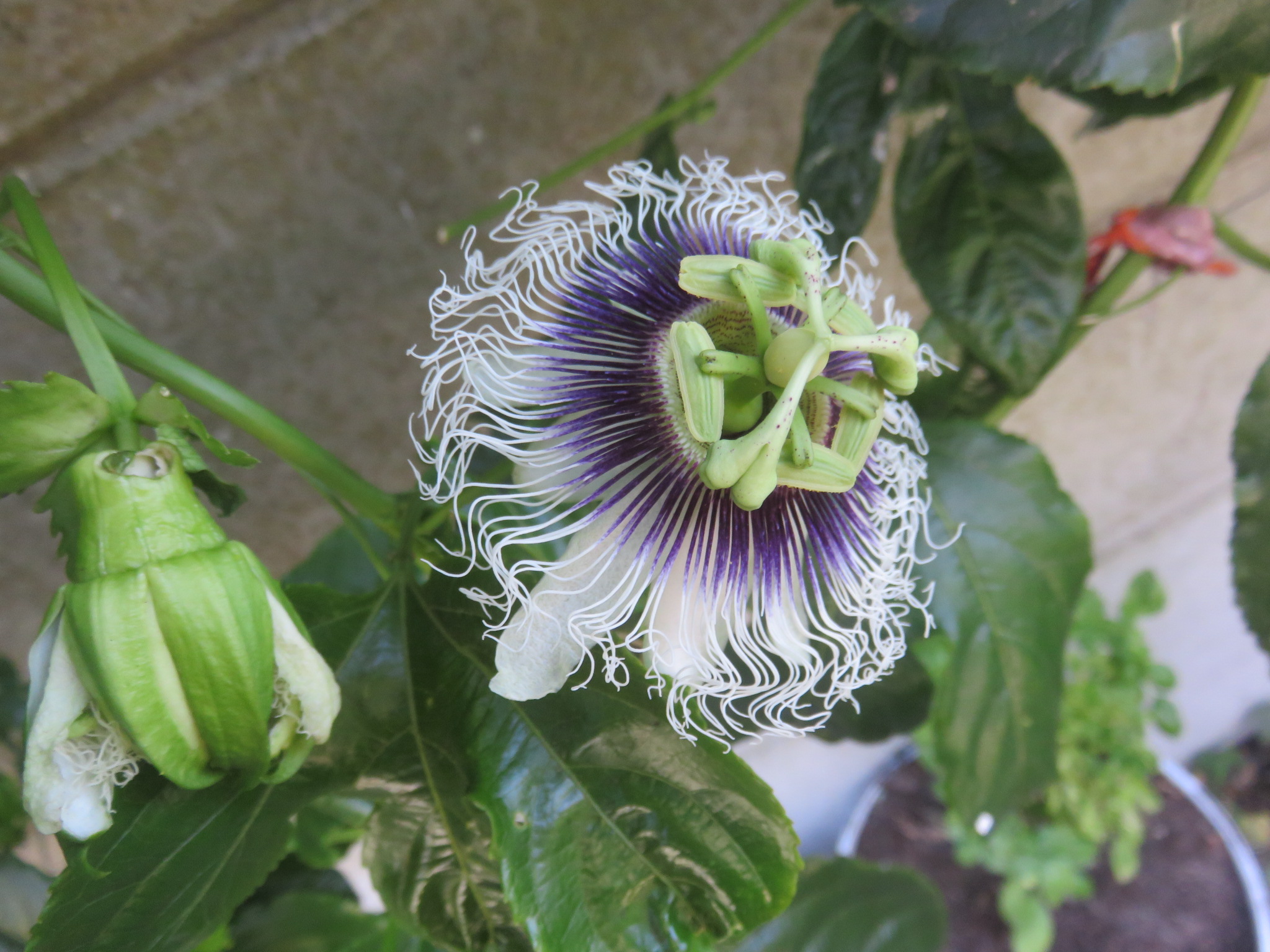 The commercial vine The commercial vine |
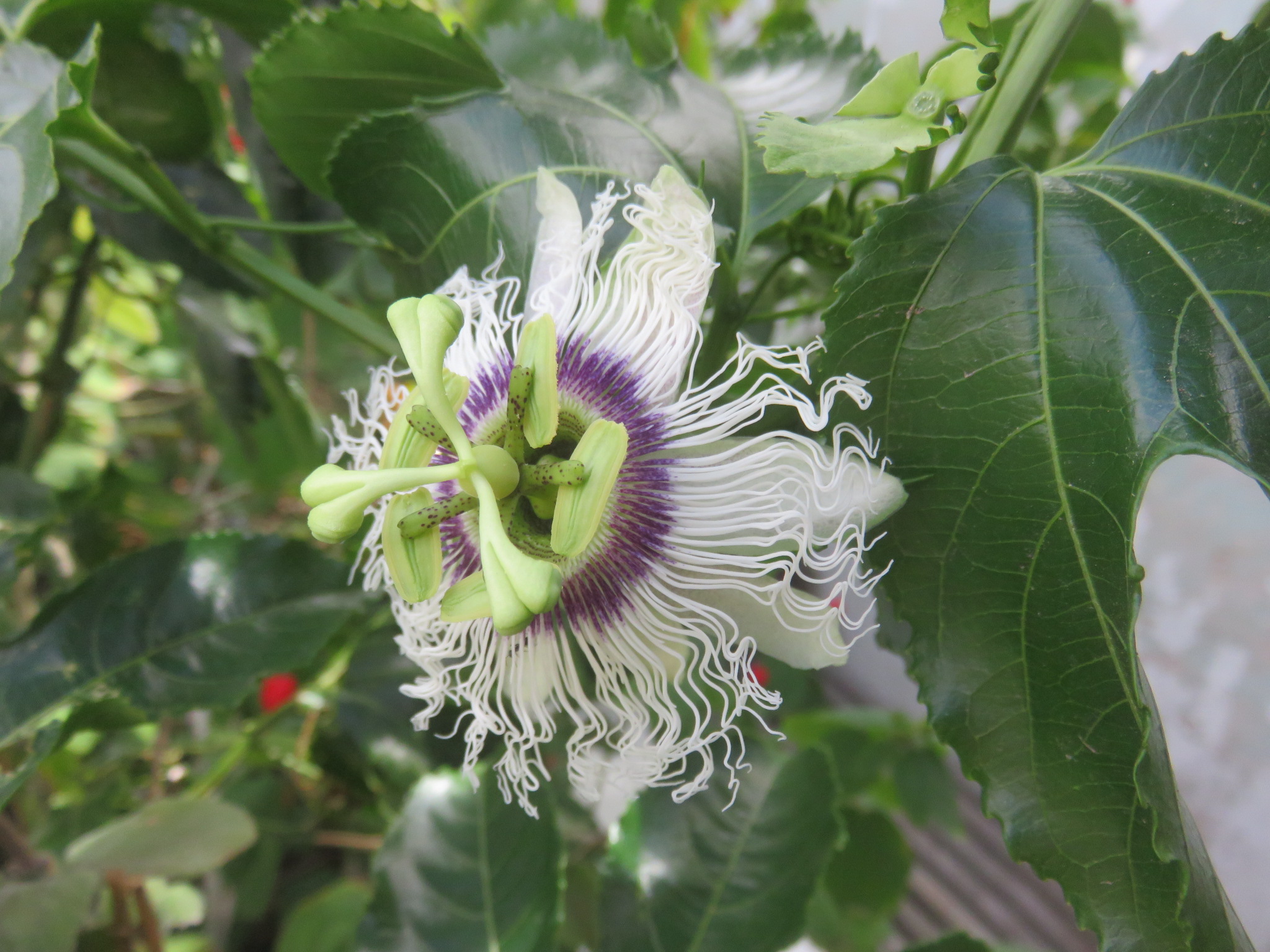 Home grown vine Home grown vine |
The granadilla vine is very lush and attractive, and soon developed an ecosystem of
its own in one corner of the garden, a special spot requiring very
little irrigation once established.
Growing granadilla vines also appeals to the gardener building a productive food garden, as it is a fruiting vine, and in urban spaces we often have more vertical than horizontal space in the garden. My perimeter walls are about 115 meters squared in vertical area, and the house 120 square meters, whereas the back garden's horizontal ground space is only 100 meters squared.
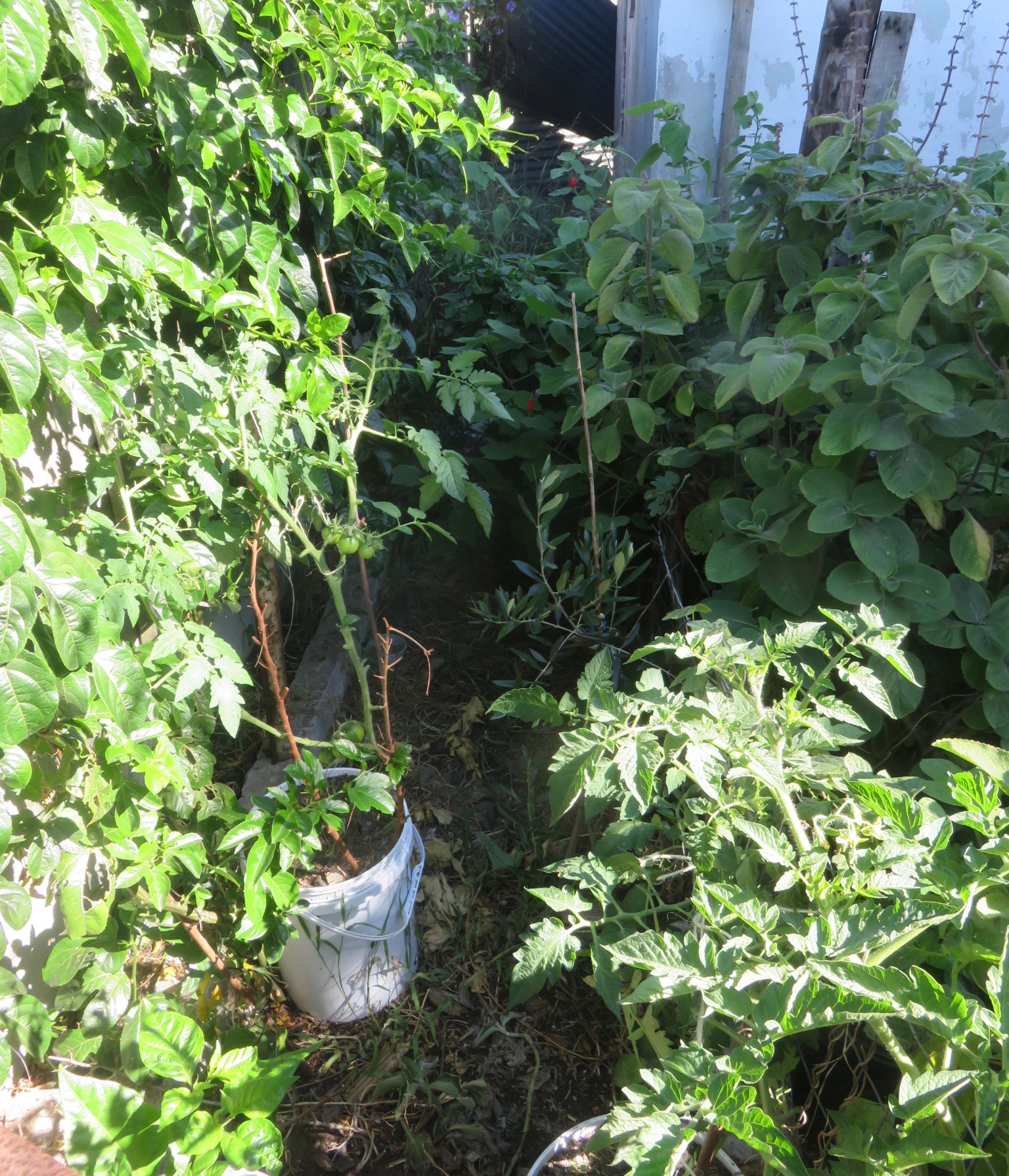 The vine soon covered a concrete wall and created a protected ecosystem in this corner, where all plants require less irrigation.
The vine soon covered a concrete wall and created a protected ecosystem in this corner, where all plants require less irrigation. The bought vine spreads from left of the tree through to the vertical posts on the right, flanked by small home grown vines, like the one on the vertical posts.
The bought vine spreads from left of the tree through to the vertical posts on the right, flanked by small home grown vines, like the one on the vertical posts.Thus, if we use our vertical space productively we can triple the growing area of the garden that harvests the sun's energy and turns it to food. This is a good reason to grow passion fruit, and also to cover the garden fences and house walls with grapes, hops, melons, beans and cucurbits with edible leaves, kiwis, edible roses and climbing spinach. I choose perennial food plants whenever possible, as they are better for soil conservation and nutritional content. Have a look at my justifications on the page about perennial food plants.
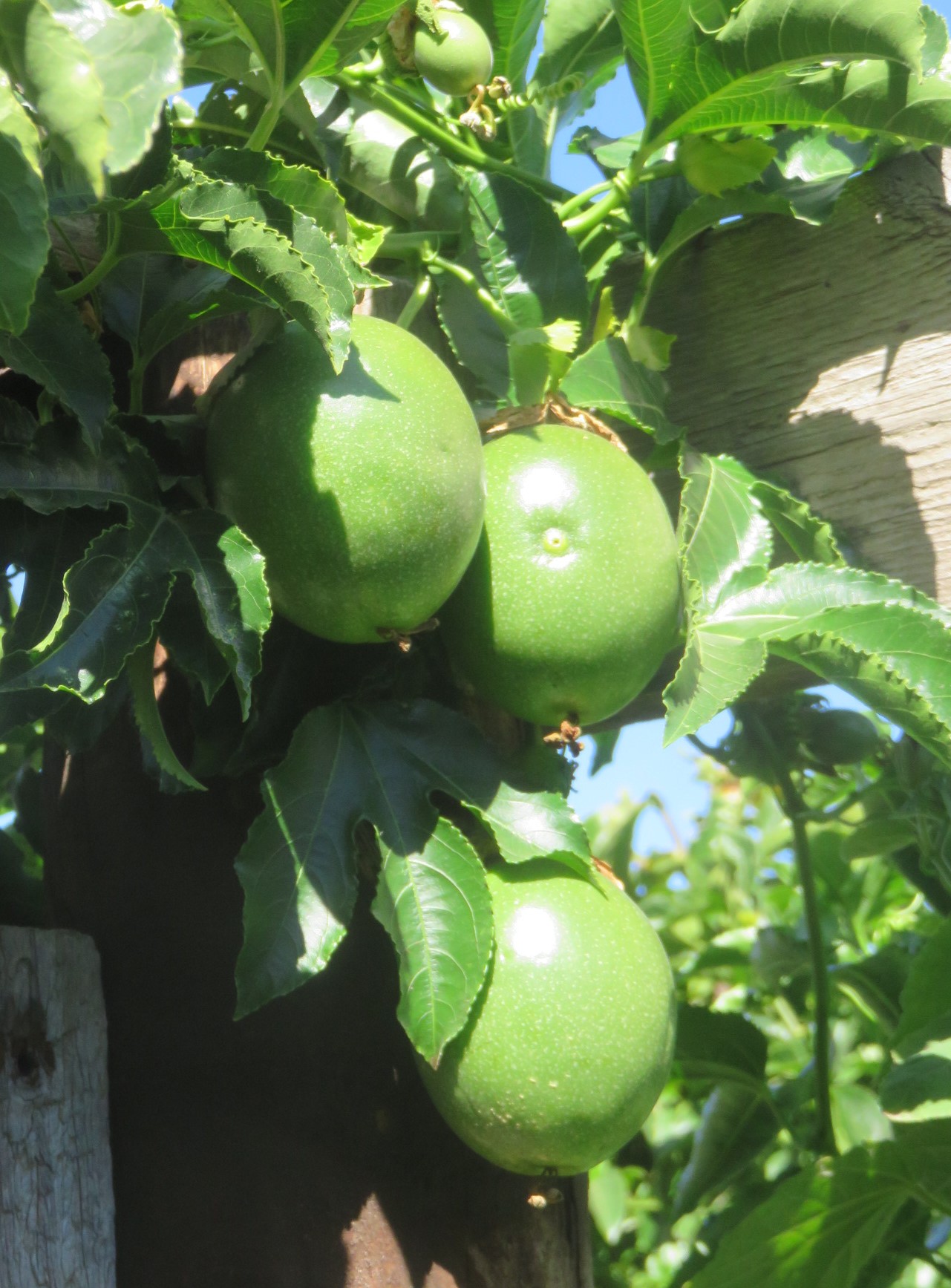 The small home grown vine
The small home grown vineHowever there is another reason to grow passion fruit. Passiflora is also a medicinal herb that is reputed to help with calming the mind and sleep, though this is denied by the FDA. With today's stressful lifestyles, and given the known degenerative effects of stress on the body, we all have need of as many different calming herbs as possible to use in a crisis. Spreading the medicinal load over many different herbs in sequence reduces the potential toxic effect or habituation that can occur when using only one type. My very first impulse to grow passion fruit was to use it as a medicine, during a very stressful period of life.
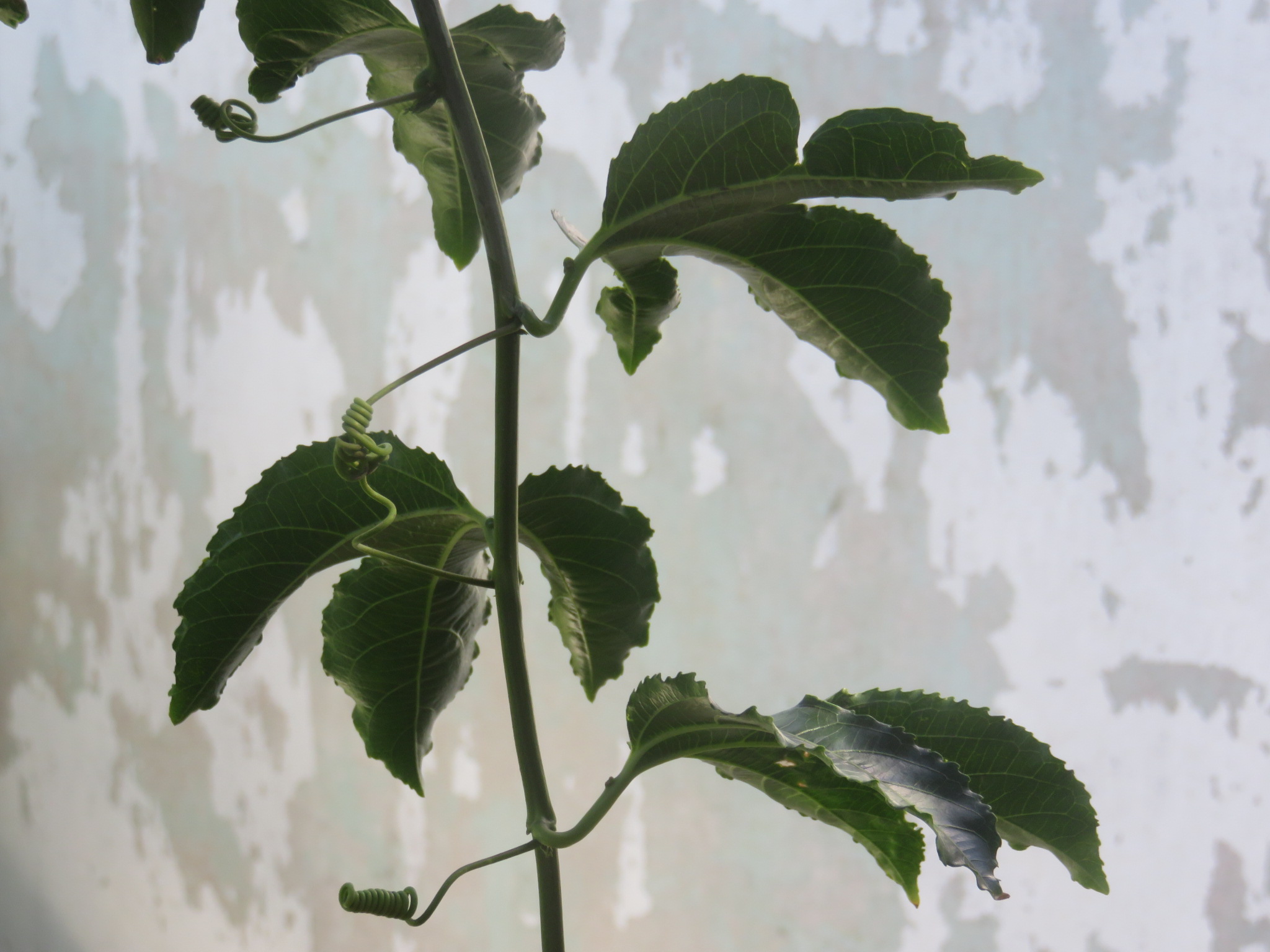 Grow passion fruit as a herb promising tranquility
Grow passion fruit as a herb promising tranquilityHistory and diversity of passion fruit
Like many other fabulous perennial food plants, the passion fruit originated in Amazonian Brazil. The early Jesuit missionaries, when they first saw the granadilla flower, interpreted it as a sign of Christ's passion, leading to the name it was given in English and other languages. Its symbolism was based on the numbers of flower parts, but the extraordinary beauty and nimbus or halo-like like
quality of the circular arrangement must have first drawn attention to it.
The ten petals stood for the ten faithful apostles, the three
stigmas symbolized the three nails, the five anthers the five wounds,
the spiky appearance of the center was for the crown of thorns, and the fine, wavy, thread like appendages of the corona represented whip lashes.
The genus Passiflora has been very successful and diversified into 550 species, of splendid colours and forms, such as the gorgeous mauve Passiflora crenata, or maypop, which flourishes in the South Eastern United States.
Most varieties of Passiflora originate in South and Central America, like Passiflora edulis, the common passion fruit. This colonial inheritance passed into Portugal's cuisine and its street markets sell an enormous diversity of passion fruit types.
------
home page for articles on natural and regenerative gardening
------
------
four different varieties of granadilla in a market in Funchal
Restore Nature Newsletter
I've been writing for four years now and I would love to hear from you
Please let me know if you have any questions, comments or stories to share on gardening, permaculture, regenerative agriculture, food forests, natural gardening, do nothing gardening, observations about pests and diseases, foraging, dealing with and using weeds constructively, composting and going offgrid.
What Other Visitors Have Said
Click below to see contributions from other visitors to this page...
Passion Fruit 




You should try cuttings from your bearing plant, which should duplicate the plant you have. There are video's on youtube showing how. Seeds does not necessarily …
SEARCH
Order the Kindle E-book for the SPECIAL PRICE of only
Prices valid till 30.09.2023
Recent Articles
-
garden for life is a blog about saving the earth one garden at a time
Apr 18, 25 01:18 PM
The garden for life blog has short articles on gardening for biodiversity with native plants and regenerating soil for climate amelioration and nutritious food -
Cape Flats Sand Fynbos, Cape Town's most endangered native vegetation!
Apr 18, 25 10:36 AM
Cape Flats Sand Fynbos, a vegetation type found in the super diverse Cape Fynbos region is threatened by Cape Town's urban development and invasive alien plants -
Geography Research Task
Jan 31, 25 11:37 PM
To whom it may concern My name is Tanyaradzwa Madziwa and I am a matric student at Springfield Convent School. As part of our geography syllabus for this
"How to start a profitable worm business on a shoestring budget
Order a printed copy from "Amazon" at the SPECIAL PRICE of only
or a digital version from the "Kindle" store at the SPECIAL PRICE of only
Prices valid till 30.09.2023







